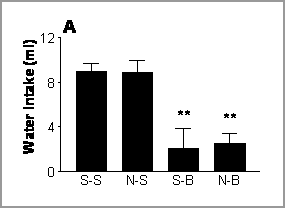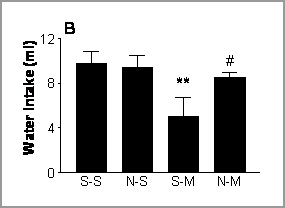Effects of the opioid receptor antagonist naloxone on baclofen- and morphine-induced hypodipsia in rats Previous studies have shown that, like the mu-opioid receptor agonist morphine (Akil et al., 1976; Cooper, 1981), the GABAB receptor agonist baclofen inhibits water intake in water deprived rats (Ebenezer et al., 1992) and displays antinociceptive properties in mice which is naloxone sensitive (Aley et al., 1991). The neurochemical mechanism(s) by which baclofen suppresses water intake remains to be elucidated. The present study was undertaken to investigate if the inhibitory effects of baclofen on water intake in rats involve an opioid mechanism. Male Wistar rats (n=16; b. wt. 300 – 340g) were housed in groups of 4 and had free access to food in their home cages. The animals were divided into two equal groups, a baclofen treatment group (Group 1, n=8) and a morphine treatment group (Group 2, n=8). The animals were deprived of water in their home cages for 16 h each day. During experimental trials, the rats in Group 1 were injected s.c. with either saline followed 15 min later by saline., saline followed by baclofen (2 mg kg -1), naloxone (0.25 mg kg -1) followed by saline, or naloxone followed by baclofen. The rats in Group 2 were similarly treated except that they received morphine (5 mg kg-1; s.c.) instead of baclofen. Fifteen min after the 2nd injection the rats were placed singly in separate experimental cages with free access to water and intake measured, as described previously (Ebenezer et al., 1992). A repeated measures design was used with each rat receiving all treatments; 3 – 4 days separated successive drug trials. The data were analysed by ANOVA and Newman-Keuls post-hoc test. Under control conditions the animals drank most of their water during the first 15 min after exposure. Both baclofen (Group 1) and morphine (Group 2) significantly suppressed water intake at 15 min (P<0.01 in each case, see Figs 1A & B). Naloxone (0.25 mg kg-1) did not produce significant changes in water intake on its own, nor did it affect the suppressant effect of baclofen on water consumption (Fig.1A). However, the opioid receptor antagonist significantly attenuated the morphine-induced hypodipsia (P<0.05, Fig.1B). These findings therefore suggest that while the suppressant effect of morphine on water intake is mediated by an opioid mechanism, it is unlikely that GABAB receptor agonist baclofen elicits its hypodipsic effects by interacting with an opioid system.
Fig. 1. Effects of naloxone (N) on baclofen (B) and morphine (M)-induced hypodispsia in water-deprived rats. Vertical lines rep. + s.e.m. **P<0.01 vs saline (S) control. #P<0.05 vs S-M.
Akil, H. et al. (1976) Science, 191, 961 – 962. |
|



